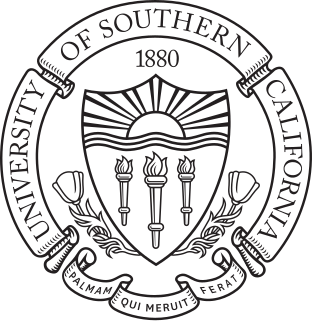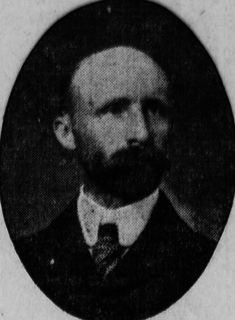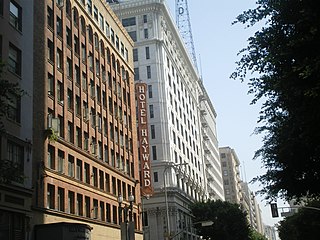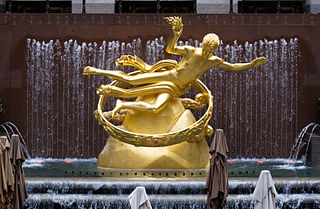
The University of Southern California is a private research university in Los Angeles, California, United States. Founded in 1880 by Robert M. Widney, it is the oldest private research university in California.
The University of Southern California School of Cinematic Arts (SCA) houses seven academic divisions: Film & Television Production; Cinema & Media Studies; John C. Hench Division of Animation + Digital Arts; John Wells Division of Writing for Screen & Television; Interactive Media & Games; Media Arts + Practice; Peter Stark Producing Program.

The Southern California Earthquake Center (SCEC) is a collaboration of more than 1,000 scientists across 100 research institutions with a mission to: conduct research on earthquakes in Southern California and elsewhere by gathering data, conducting theoretical studies, and performing computer simulations; integrate information into a comprehensive, physics-based understanding of earthquake phenomena; and communicate that understanding to end-users and society at large as useful knowledge for reducing earthquake risk and improving community resilience..

Los Angeles County+USC Medical Center, also known as County/USC, or by the abbreviation LAC+USC, is a 600-bed public teaching hospital located at 2051 Marengo Street in the Boyle Heights neighborhood of Los Angeles, California. As implied by the name, the hospital facility is owned by the Los Angeles County and operated by the Los Angeles County Department of Health Services, while doctors are faculty of the Keck School of Medicine of USC, who oversee more than 1,000 medical residents being trained by the faculty.

Romanesque Revival is a style of building employed beginning in the mid-19th century inspired by the 11th- and 12th-century Romanesque architecture. Unlike the historic Romanesque style, Romanesque Revival buildings tended to feature more simplified arches and windows than their historic counterparts.
James Herbert Zumberge was a professor of geology and president of Grand Valley State University from 1962 to 1969, of Southern Methodist University from 1975 to 1980, and of the University of Southern California from 1980 to 1991.

George Edwin Bergstrom was an American architect who designed The Pentagon in Arlington County, Virginia.

John and Donald Parkinson were a father-and-son architectural firm operating in the Los Angeles area in the early 20th century. They designed and built many of the city's iconic buildings, including Grand Central Market, the Memorial Coliseum and the City Hall.

Steven Browning Sample was the 10th president of the University of Southern California (USC). He became president in 1991 and was succeeded by C. L. Max Nikias on August 3, 2010. Prior to his presidency at USC, Sample was the 12th president of the University at Buffalo (UB) in the State University of New York (SUNY) system from 1982 to 1991. He was succeeded at UB by Bill Greiner.
John Randolph Hubbard was an American educator, academic administrator, and diplomat who served as the eighth president of the University of Southern California from 1970 and 1980.

Anthony Lazzaro was an American academic administrator. He was vice president of the University of Southern California (USC) from 1988 until his retirement in 1991, having served the institution in a variety of administrative roles from 1948. He is credited with having expanded the campus infrastructure of USC from 11 permanent buildings to over 132 buildings, and for planning the construction of venues for the 1984 Summer Olympics in Los Angeles.

Hugo Ballin NA was an American artist, muralist, author, and film director. Ballin was a member of the National Institute of Arts and Letters and the National Academy of Design.
The Campus of the University of Southern California, also known as the University Park Campus is located in the Exposition Park neighborhood of Los Angeles, California. The campus sprawls across 226 acres and contains most of the academic facilities and residential buildings of the University of Southern California. The University Park campus is in the University Park district of Los Angeles, 2 miles (3.2 km) southwest of downtown Los Angeles. The campus's boundaries are Jefferson Boulevard on the north and northeast, Figueroa Street on the southeast, Exposition Boulevard on the south, and Vermont Avenue on the west. Since the 1960s, through-campus vehicle traffic has been either severely restricted or entirely prohibited on some thoroughfares. The University Park campus is within walking distance to Los Angeles landmarks such as the Shrine Auditorium and Los Angeles Memorial Coliseum, which is operated and managed by the University. Most buildings are in the Romanesque Revival style, although some dormitories, engineering buildings, and physical sciences labs are of various Modernist styles that sharply contrast with the predominantly red-brick campus. Widney Alumni House, built-in 1880, is the oldest university building in Southern California. In recent years the campus has been renovated to remove the vestiges of old roads and replace them with traditional university quads and gardens. The historic portion of the main campus was listed on the National Register of Historic Places in 2015.

Spring Street in Los Angeles is one of the oldest streets in the city. Along Spring Street in Downtown Los Angeles, from just north of Fourth Street to just south of Seventh Street is the NRHP-listed Spring Street Financial District, nicknamed Wall Street of the West, lined with Beaux Arts buildings and currently experiencing gentrification. This section forms part of the Historic Core district of Downtown, together with portions of Hill, Broadway, Main and Los Angeles streets.
The USC School of Architecture (USCArchitecture) is the architecture school at the University of Southern California. Located in Los Angeles, California, it is one of the university's twenty-two professional schools, offering both undergraduate and graduate degrees in the fields of architecture, building science, landscape architecture and heritage conservation.

The Metropolitan Building, in Los Angeles, California, was completed in 1913 and is one of a number of buildings built along Broadway in the early decades of the twentieth century for commercial and retail uses in what had then become the busiest and largest shopping district of the city. Located at the intersection of W. 5th Street and S. Broadway, the Metropolitan Building replaced a two-story, Romanesque Revival style building with storefronts on S. Broadway and W. 5th Street. This building was called the Mueller Building for its owner, Michail Mueller. The date of the building's construction is not known, nor has any additional information about it been located.

Bob Hope Patriotic Hall is a 10-story building that was dedicated as Patriotic Hall by the Los Angeles Board of Supervisors in 1925 and was built to serve veterans of Indian Wars, Spanish–American War, World War I and to support the Grand Army of the Republic. It serves as the home of the Los Angeles County Department of Military and Veterans Affairs. Patriotic hall was rededicated to honor of Bob Hope and renamed "Bob Hope Patriotic Hall" on November 12, 2004.
Brenda A. Levin is a Los Angeles-based architect and advocate for historic preservation. A Fellow of the American Institute of Architects (AIA), her major projects include the restoration of iconic L.A. landmarks like the Bradbury Building, the Griffith Observatory, the Wiltern Theatre, City Hall, Grand Central Market, and Dodger Stadium.

The Art Deco style, which originated in France just before World War I, had an important impact on architecture and design in the United States in the 1920s and 1930s. The most famous examples are the skyscrapers of New York City including the Empire State Building, Chrysler Building, and Rockefeller Center. It combined modern aesthetics, fine craftsmanship and expensive materials, and became the symbol of luxury and modernity. While rarely used in residences, it was frequently used for office buildings, government buildings, train stations, movie theaters, diners and department stores. It also was frequently used in furniture, and in the design of automobiles, ocean liners, and everyday objects such as toasters and radio sets. In the late 1930s, during the Great Depression, it featured prominently in the architecture of the immense public works projects sponsored by the Works Progress Administration and the Public Works Administration, such as the Golden Gate Bridge and Hoover Dam. The style competed throughout the period with the modernist architecture, and came to an abrupt end in 1939 with the beginning of World War II. The style was rediscovered in the 1960s, and many of the original buildings have been restored and are now historical landmarks.














